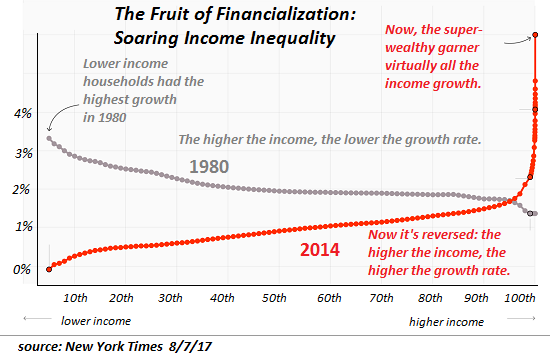Summary:
Self-destruction isn’t a bug, it’s a feature of our socio-economic system. The gravitational pull of self-destructive behaviors, choices and incentives is scale-invariant, meaning that we can discern the strange attraction to self-destruction in the entire scale of human experience, from individuals to families to groups to entire societies. The proliferation of self-destructive behaviors, choices and incentives in our socio-economic system is profoundly troubling. Exhibit 1 is the opioid epidemic (charts below). How did we reach this level of individual and social self-destruction? There are culprits aplenty: a “healthcare” (sickcare) system that incentivizes maximizing profits by whatever means are available (for
Topics:
Charles Hugh Smith considers the following as important: 5) Global Macro, Featured, newsletter
This could be interesting, too:
Self-destruction isn’t a bug, it’s a feature of our socio-economic system. The gravitational pull of self-destructive behaviors, choices and incentives is scale-invariant, meaning that we can discern the strange attraction to self-destruction in the entire scale of human experience, from individuals to families to groups to entire societies. The proliferation of self-destructive behaviors, choices and incentives in our socio-economic system is profoundly troubling. Exhibit 1 is the opioid epidemic (charts below). How did we reach this level of individual and social self-destruction? There are culprits aplenty: a “healthcare” (sickcare) system that incentivizes maximizing profits by whatever means are available (for
Topics:
Charles Hugh Smith considers the following as important: 5) Global Macro, Featured, newsletter
This could be interesting, too:
Nachrichten Ticker - www.finanzen.ch writes Die Performance der Kryptowährungen in KW 9: Das hat sich bei Bitcoin, Ether & Co. getan
Nachrichten Ticker - www.finanzen.ch writes Wer verbirgt sich hinter der Ethereum-Technologie?
Martin Hartmann writes Eine Analyse nach den Lehren von Milton Friedman
Marc Chandler writes March 2025 Monthly
Self-destruction isn’t a bug, it’s a feature of our socio-economic system.
The gravitational pull of self-destructive behaviors, choices and incentives is scale-invariant, meaning that we can discern the strange attraction to self-destruction in the entire scale of human experience, from individuals to families to groups to entire societies.
The proliferation of self-destructive behaviors, choices and incentives in our socio-economic system is profoundly troubling. Exhibit 1 is the opioid epidemic (charts below). How did we reach this level of individual and social self-destruction?
There are culprits aplenty: a “healthcare” (sickcare) system that incentivizes maximizing profits by whatever means are available (for example, claiming addictive medications aren’t addictive); a system that encourages the consumption of costly prescriptive medications without regard to their interactions; a system that establishes a “standard of care” that relies on prescribing pills of one kind or another; a system that treats psychological-physical pain with painkillers rather than treat the source of the pain; a system that cannot recognize spiritual pain (from losing sources of meaning, purpose and positive social roles) much less address it; a workers compensation system that incentivizes vague pain-related injuries as a way of getting a vacation from work; a pharmaceutical industry hard-wired to seek and promote “the next billion-dollar drug” regardless of the long-term consequences of the wonder-drug, and a culture that worships convenience and the illusion that instant remedies to chronic conditions are available or should be available.
That is of course only a partial list.
Dependencies are one of the many self-destructive attractors in our society.Dependencies on addictive substances is one manifestation of self-destructive behavior, but dependency on an institution that leads to a loss of self-reliance is also a subtle form of self-destruction.
Strange attractors are mathematical structures within fractal systems that are extremely sensitive to initial conditions within the system. Strange attractors are not a perfect analogy for the many self-destructive dynamics in our socio-economic system, but they do help us understand how the initial conditions established within the system end up defining the incentive structure that then rewards or punishes various behaviors and choices.
So if we “reward” doctors for prescribing painkillers and patients for taking them, an opioid epidemic was essentially built into the system by these initial conditions. The same can be said of our financialized economic system that rewards speculative gambles backstopped by the central bank or state: once those are the initial conditions of the financial system, it’s literally “crazy” not to borrow billions to gamble or buy back your own corporation’s shares.
|
Then there’s our foreign policy, which is dominated by strange attractors for self-destructive policies such as wars of choice, New Cold Wars, we came, we saw, he died “interventions” and so on.
Notice the recent sharp rise in opioid deaths distributed by our “healthcare” system. After the addict has been exploited for profit, heroin becomes the next attractor.
|
US Overdose Deaths, 2000 - 2016 |
| Do you reckon a system whose initial conditions reward those at the top of the wealth-power pyramid to the exclusion of the bottom 95% might have something to do with our social-economic self-destruction? |
The Fruit of Financialization, 1980 - 2014 |
| Here’s a chart of employment trends: aging workers can’t afford to retire, while the under-55 work force has been treading water. Might this have some negative effect on the well-being of the populace? |
Cumulative Change in Employment, 2000 - 2018 |
| The Japanese term describing a life of meaning, purpose and positive social roles–ikigai— has caught on in certain policy circles. A life of meaning, purpose and positive social roles is the core reason (along with a diet of plant-based real food) that Okinawans are remarkably healthy and long-lived. |
Ikigai |
If you designed a system that had zero incentives via its initial conditions for the nurturing of ikigai, you’d have the status quo. Self-destruction isn’t a bug, it’s a feature of our socio-economic system, built into the system’s initial conditions.
Tags: Featured,newsletter




